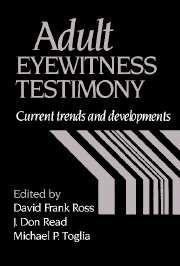Book contents
- Frontmatter
- Contents
- List of contributors
- Preface
- Part I Cognitive, physical and social processes and factors influencing eyewitness recall and identification
- Part II Lineup construction and collection of testimony
- 8 Conceptual, practical, and empirical issues associated with eyewitness identification test media
- 9 Biased lineups: Where do they come from?
- 10 Evaluating the fairness of lineups
- 11 Recommendations for properly conducted lineup identification tasks
- 12 Improving eyewitness testimony with the Cognitive Interview
- Part III Whom to believe? Distinguishing accurate from inaccurate eyewitnesses
- Name index
- Subject index
8 - Conceptual, practical, and empirical issues associated with eyewitness identification test media
Published online by Cambridge University Press: 04 August 2010
- Frontmatter
- Contents
- List of contributors
- Preface
- Part I Cognitive, physical and social processes and factors influencing eyewitness recall and identification
- Part II Lineup construction and collection of testimony
- 8 Conceptual, practical, and empirical issues associated with eyewitness identification test media
- 9 Biased lineups: Where do they come from?
- 10 Evaluating the fairness of lineups
- 11 Recommendations for properly conducted lineup identification tasks
- 12 Improving eyewitness testimony with the Cognitive Interview
- Part III Whom to believe? Distinguishing accurate from inaccurate eyewitnesses
- Name index
- Subject index
Summary
Introduction
In our attempts to devise methods for improving the accuracy of eyewitness identification, a considerable portion of our research has focused on the role of the identification test medium (ITM), that is, whether the identification test consists of a live lineup, videotaped lineup, or photo array. Traditionally, identification tests have consisted of live lineups or photo arrays, but videotaped lineups have become more prevalent, due to the accessibility of high quality, inexpensive, and user-friendly audiovisual technology. This chapter reviews the conceptual distinctions pertaining to the ITM, the practical considerations associated with ITM, and empirical studies that directly compare identification performance as a function of ITM. In addressing the latter, we quantitatively review a large body of literature within which ITM was manipulated between or across experiments. Our goal is to draw conclusions about the role of ITM based on existing research and to clarify the practical implications arising from those findings. Despite the considerable number of experiments addressing ITM, we find many important questions unanswered, and we therefore discuss directions for further research.
Conceptual distinctions among identification test media
An inherent distinction between various ITMs is image quality. Common sense tells us that live lineups produce the clearest image; reproducing these images, in any manner, can only lead to poorer quality. Live lineups would therefore be expected to produce identification performance superior to both videotaped lineups and photo arrays. Whether inherent differences in image quality affect identification performance in eyewitness cases is open to debate. The influence of image quality on identification performance might depend on a practical consideration, reproduction quality.
- Type
- Chapter
- Information
- Adult Eyewitness TestimonyCurrent Trends and Developments, pp. 163 - 181Publisher: Cambridge University PressPrint publication year: 1994
- 29
- Cited by

